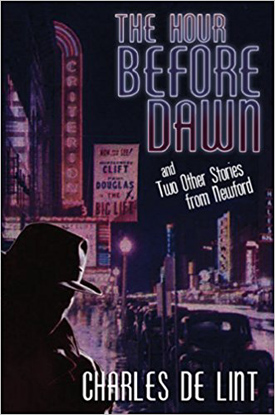 This volume was my first encounter with Charles de Lint’s Newford. Strangely enough, these works, particularly the title story, remind me very strongly of some of Jonathan Lethem’s stories, and I couldn’t begin to say why. De Lint’s stories are nowhere near so fundamentally cynical, nor so hopelessly nihilistic — in fact, quite the opposite. Perhaps it is simply that the two share an outlook in which anything can happen and the ability to draw a world in which it probably will.
This volume was my first encounter with Charles de Lint’s Newford. Strangely enough, these works, particularly the title story, remind me very strongly of some of Jonathan Lethem’s stories, and I couldn’t begin to say why. De Lint’s stories are nowhere near so fundamentally cynical, nor so hopelessly nihilistic — in fact, quite the opposite. Perhaps it is simply that the two share an outlook in which anything can happen and the ability to draw a world in which it probably will.
De Lint says in his foreword that he loves writing stories because they give him a chance to “colour outside the lines,” but I find that, like all writers, he comes back to his ongoing concerns; in this case, all three stories are about having another chance, the opportunity to surmount, somehow, past blunders and bad choices, an idea that pops up repeatedly in his novels. That the characters must take a chance to have that chance — well, that’s what life is, isn’t it?
The title story takes place in 1957, about a classic down-at-the heels private eye who gets visits from the dead in the hour before dawn. Everyone does, but he remembers these visits. The problem now is that the visitor is none other than his former sister-in-law, whom he despised when she was alive, and who doesn’t seem to have become Ms. Sweetness and Light since. But in de Lint’s universe, even the dead can change, particularly when we learn that the dead not only visit those who can help them, but also visit those they can help.
“That Was Radio Clash” is a memorial to Joe Strummer, most famously of Clash, and it’s a story in which de Lint’s love of music comes through strongly. It picks up the theme of the first story, as well — in this case, not only is Sarah Blue given another chance, but she passes along the gift.
In “The Butter Spirit’s Tithe,” the story of a young musician who runs afoul of a touchy — and not terribly honest — spirit, de Lint takes a slightly different approach, once again bringing his signature blending of Celtic and North American mythology into play. As so often in de Lint’s storytelling, the key factors in Conn O’Neill’s second chance are love, and trust in the not-quite earthly.
In addition to the stories, we are presented with two illustrations by de Lint, for “The Hour Before Dawn” and “This Was Radio Clash.” They are photographic triptychs, and both are built around a central image that sets a scene; the smaller insets pick up details from the story — a graveyard, a young woman from the punk scene — that resonate across the central image, proving that de Lint can write with images as well as words.
De Lint does play with these stories, the kind of playing that a writer might do and a reader not even notice, necessarily, such as writing in the present tense. These three tales are, however, solidly crafted stories that are ultimately pure de Lint. He’s a master of his craft, and I’m not inclined to quibble. I’d much rather just kick back and enjoy.
(Subterranean Press, 2005)
